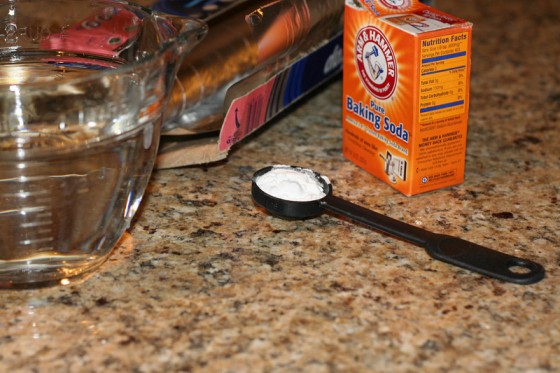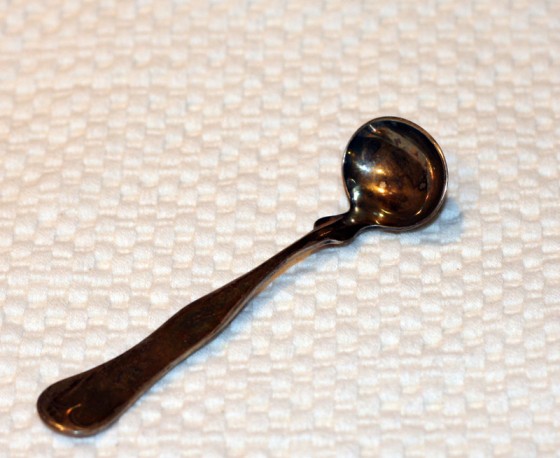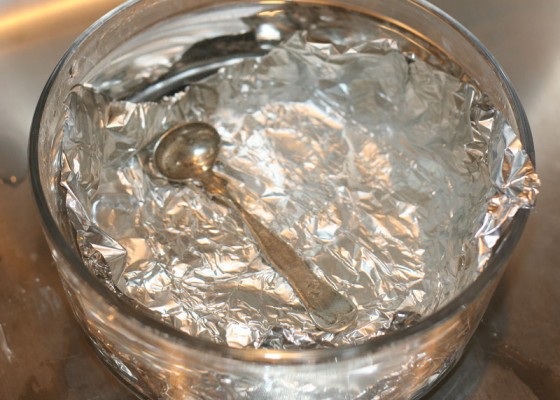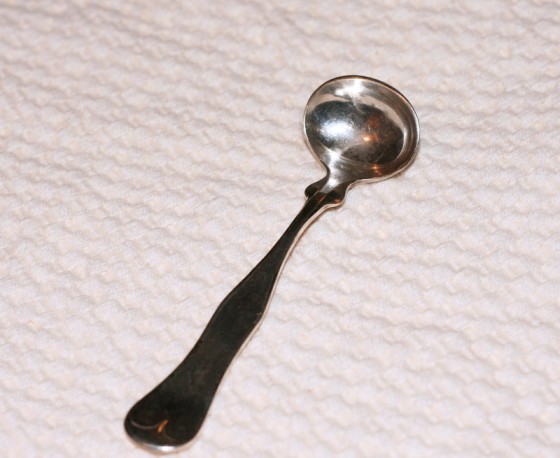How To
Homemade Silver Cleaner | Polish Silver without Harsh Chemicals
Wondering how to clean tarnished silver? Here’s a homemade silver cleaner that works fast. It’s a natural silver cleaner, DIY-style.

Coffee By Design | Portland, Maine
Photo Credit : Katherine KeenanHOMEMADE SILVER CLEANER | DIY ADVICE
Ingredients for Homemade Silver Cleaner:
- 1 quart of hot water
- 1 tablespoon of baking soda
- 1 sheet of aluminum foil
- non-aluminum dish

Instructions for Making Homemade Silver Cleaner:
- Line bottom of non-aluminum dish with a sheet of aluminum foil
- Mix 1 tablespoon of baking soda into a quart of hot water
- Soak for a half hour — time may vary depending on degree of tarnish
- Buff with clean, dry cloth











Tried this recipe for homemade silver dip. Went exactly according to the letter
or description.. Didn’t remove any tarnish from the silver at all. There must be
an ingredient or a step or two missing.
You need to use WASHING SODA, not baking soda. Arm & Hammer makes it. It’s used in for laundry.
I used this method this morning and it worked an absolute treat using baking soda. Thank you so much! My silver is sparkling!
this didn’t work at all for me. Does it matter which side is up on the foil?
Hi Nancy — When we tested this method, we had the shiny side up. Results will vary based on the degree of tarnish.
I used this tonight for a tarnished James Avery ring. It worked wonders. The extra ingredients not listed are:
Salt
Vinegar
Worked like a champ and fast. I thought my ring was ruined but this proved otherwise.
Lipstick works great for silver jewelry.
Betsy is right about the salt, but not the vinegar (the acid and the baking soda just neutralize each other). Washing soda is a whitening agent, but I doubt it would remove silver tarnish.
Instructions I’ve seen before for this method say to head the solution, I think. I have used it with excellent results, but there’s one important caveat…
This process dulls the silver–i.e., you get the tarnish off, but the finish is no longer shiny. Perhaps a rubbing-compound polish would restore the sheen.
Hi Barry, this homemade silver cleaner did not work for me also
This method has worked great for me for many years. I use a Pyrex 9×13 cake pan or measuring cup. First put in a single sheet of Reynolds Wrap. Place item. Tea kettle boiling water. Pour water level over item slightly. Add baking soda. It reacts with fizzing. Let set 15 to 30 minutes. Remove and rinse under cold water. Dry. If let dry on its own stain will set. To repeat use another fresh tin foil. Merry Christmas.
I am going to try this on an antique silver tea pot and serving platter I inherited from Grandmother. Any suggestions before I do?
Don’t do it on heirloom or anything you care about!!!!
Hi Mary,
Please be sure to read our note about this being a last resort method in the opening paragraph. While this method will remove the tarnish without chemicals, it can leave your silver looking flat.
Wow! That is something new! To clean silver with simple baking soda sounds almost impossible! I will definitely try this unusual and curious way of silver cleaning! Regards!Clerkenwell Carpet Cleaners Ltd.
Test solution on a small out of the way area, such as the bottom of either, and test only with a small amount.
My daughter added bleach to the water and didn’t realize our silverware utensils were soaking. Needless to I thought I had lost half of my silverware. The utensils were badly tarnished. I used a combination of toothpaste, soapy water ( dish soap) and I used your homemade polish of the foil, boiling water, baking soda, table salt and sea salt. My set was so badly tarnished from the bleach that I had to scrub and soak them in the solution four times. I am happy to say my silverware is back sparkling as if nothing ever happened to them. I am so happy, this utensil set is old and has been passed down, I am the third generation, I thought i had lost half my set. Thanks for the tip.
Oh my goodness! I am stunned! The same thing happened to me, but unlike you, I threw away my silver plate soup spoons thinking they were no more good. I actually read somewhere that when bleach takes out the color the plateing is ruined. Glad to find your post though a little late to save me..
This post is just what I needed. I needed my silver cleaned for so long. Thanks for sharing <3
Toothpaste is the secret ingredient that worked for me. Thanks for the suggestion. I first used used Baking Soda and lemon juice, which did a pretty good job, but the toothpaste really got almost all the last hard to get tarnish. Washed it off and buffed it up after, as I think you always have to do to get that shine.
The only reason this method wouldn’t work is if the metal in’t silver. Silver turns black. If you see white tarnish its aluminium with a silver plate that’s worn off. If its green then its brass with the silver plate worn off. The black will come off. I think adding vinegar will speed the process but pit the surface, destroying silver plate quickly. For vintage/heirloom pieces use a quality polish as the author recommends.
Thank you Richard for teaching me my “learn at least one new thing every day” so early in the day – it’s before 7 a.m. where I live. I didn’t know such a product existed and am assuming washing soda is found with laundry detergents, etc. I will look for some when I shop next.
Shirley Stewart
Penticton, BC Canada
This does work, use shiny side of foil tho’ and you could try adding the salt. Worked both ways for me 🙂
I have used this recipe to clean my silver jewelry and it always works. It has not damaged any stones in the jewelry either. I use hot tap water, baking soda (not washing soda) and salt (any kind), Works quickly, never had any problems with it.
Worked great and fast!
THIS METHOD WILL HARM YOUR SILVER!
I have been a silver conservator for 34 years. This process, known as electrochemical (galvanic) reduction, uses aluminum foil (or an aluminum plate); a ceramic or other non-heat-sensitive bowl or pan; sodium carbonate (washing soda) or sodium bicarbonate (baking soda); and boiling water. The aluminum is placed in the bottom of the bowl with either the washing soda or baking soda distributed on the aluminum surface. Boiling water is then poured over the powder and the sterling, coin silver, .800 (or other silver-copper alloy) object is immersed. When the object comes into contact with the aluminum in the solution, the tarnish (silver sulfide) is converted back to silver. And as with silver dips, factory-applied patinas will be dissolved. These pieces will eventually require repatinating. Case in point: This action will happen to both tarnished and polished silver. (Note: washing soda etches more severely than baking soda.) Pieces cleaned may tarnish more quickly than silver that has been polished with a paste or liquid, for the object’s rough surface will act like a sponge and more readily absorb tarnish-producing gases and moisture. This same solution can also seep into hollow areas such as coffeepot and teapot handle sockets, unsoldered spun beads around the tops and bottoms of some holloware, and weighted pieces with minute holes that developed from over polishing. Another not-so-obvious problem is scratching of the object when dragged over the aluminum. For all these reasons this tarnish removal technique is not recommended.
I have been using this method for awhile and it works beautiful.
PLEASE DO NOT USE THIS TARNISH REMOVAL METHOD!
I have been a silver conservator for 34 years. This tarnish removal method will ABSOLUTELY harm your silver…
This process, known as electrochemical (galvanic) reduction, uses aluminum foil (or an aluminum plate); a ceramic or other non-heat-sensitive bowl or pan; sodium carbonate (washing soda) or sodium bicarbonate (baking soda); and boiling water. The aluminum is placed in the bottom of the bowl with either the washing soda or baking soda distributed on the aluminum surface. Boiling water is then poured over the powder and the sterling, coin silver, .800 (or other silver-copper alloy) object is immersed. When the object comes into contact with the aluminum in the solution, the tarnish (silver sulfide) is converted back to silver. And as with silver dips, factory-applied patinas will be dissolved. These pieces will eventually require repatinating. Case in point: This action will happen to both tarnished and polished silver. (Note: washing soda etches more severely than baking soda.) Pieces cleaned may tarnish more quickly than silver that has been polished with a paste or liquid, for the object’s rough surface will act like a sponge and more readily absorb tarnish-producing gases and moisture. This same solution can also seep into hollow areas such as coffeepot and teapot handle sockets, unsoldered spun beads around the tops and bottoms of some holloware, and weighted pieces with minute holes that developed from over polishing. Another not-so-obvious problem is scratching of the object when dragged over the aluminum. For all these reasons this tarnish removal technique is not recommended.
Thank you. I trust your words of wisdom. I heard that warning years ago about using the foil/baking soda method. But, as years passed, I thought that it was an error since so many people seem to swear by the method.
What do you recommend. I’ve used the baking soda method and liked it.
Minority of cases but good information anyways! If you store your silver properly, the re=tarnishing should not be a factor. For collectibles, etc, I would defer to your expertise.
Cigarette Ashes On A Soft Damp Cloth Works The Best (But I Quit Smoking)
Joanna(June) Lipstick??? WOW! Your kidding me. I will definitely try it out. I’ve used toothpaste. Not the jel. Good old fashioned white paste. Thanks.
I have a ring made from a 1947 silver quarter. I was worried about using this method because I know the ring isn’t complete silver. So I tied toothpaste with baking soda after I had washed my dishes with bleach in the water. I thought my was lost cause. The toothpaste did clean the ring but I must say it no longer shines.
I used the boiled water, foil and baking soda. Cleaned my ring beautifully, but the stone fell out because it was glued in. TOTALLY RUINED.
I’ve used the baking soda & foil trick forever and this is the only way I clean silver. It works great!
This describes a simple electrochemical reaction that ionizes the sulfites off the silver, converting back to just silver metal, and transfers the ions into aluminum sulfite or sulfate. It cannot damage sterling silver, but may cause issue with plate, and jewels or stones should not be immersed. If any dullness remains it may be the redeposited silver; using toothpaste or any other polish may increase shine, but remove the silver, never ever do this on coins! Chemical or electrochemical methods are the only way tarnish can be removed without removing silver, but polishing antiques or collectible coins may ruin their value beyond scrap silver. Only use this with caution, one piece at a time, on items you will be keeping to use, and not anything you contemplate selling.
I bought new silverware.
Lime juice and baking soda paste is working wonderfully for me
nice post